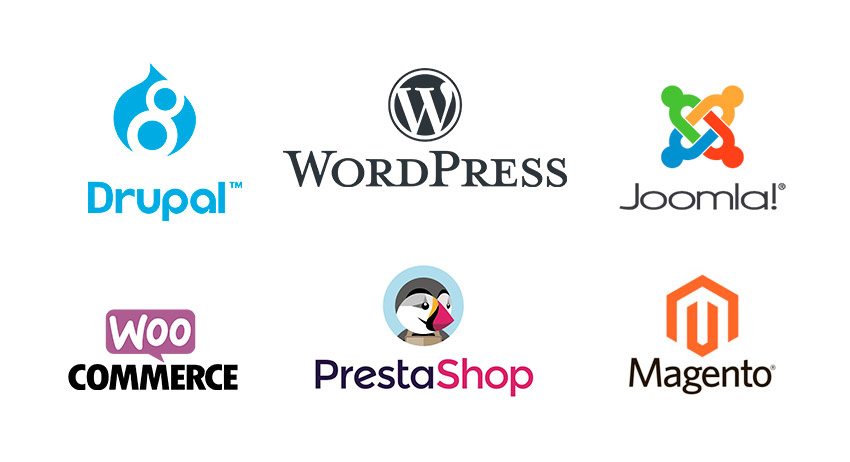Nowadays, technological development has made it much easier to create a website than in the past, when it was necessary to be a programmer, and to know several programming languages. What has facilitated this progress in the area of websites has been the content management system (CMS).
A CMS can be defined as software created for the purpose of facilitating the creation, editing and management of the content presented on a website. However, CMSs have gone one step beyond the web designThey have paid much more attention to the usability of the website.

What types of CMS are there?
Generally speaking, there are many activities that are carried out on the internet, so there are many types of CMS with different characteristics. However, we will define the 2 most important CMS for the internet, which are: CMS specialised in e-commerce, and CMS specialised in Blogs or corporate Websites. In the following, some CMS and their daily use are presented:
- WordPressThis is the flagship CMS for any project that may require a user. It is possible to use it in e-commerce, Blogs, social mediaCorporate Web... Imagination is the limit thanks to being Open Source.
- PrestaShopE-commerce CMS, which comes integrated with excellent plugins for revenue management, shopping cart system, and tools to take the shopping experience to the next level.
- JoomlaThis CMS has the advantage of being excellent for Blogs and business websites. On the other hand, it is possible to use it in e-commerce but its competitors such as WordPressPrestaShop is quite strong in this sector.
However, the most recommended CMS for all types of website is WordPressThe site is not only versatile, but also easy to optimise for SEO and likely to improve the usability of the site.
Be sure to check out this other article What is WordPress and how to protect it?or this more generic one What is Web design?
What is the structure of WordPress?
The structure of this CMS can vary depending on what type of structure we are referring to, because it can be the visible structure that is achieved by placing the extension /wp-Admin/ at the end of the URL of the Web site. On the other hand, we can talk about the structure of the template of WordPress you are using. Finally, it can be about the structure of the files and folders in WordPress that you get in the panel of the hosting service you have contracted.
In the following we will discuss each of the structures in a schematic way so as not to create confusion about each one.
Basic structure of WordPress
Any initial project of WordPress You should start with the knowledge that there is a front and a back end of the CMS. In other words, each part serves the following function:
- Frontin this section of the WordPress reflects everything that users are allowed to see, i.e. it shows the WordPress template which in principle has the following generic structure:
- Header.phpThis space is for special use to place information about the web page, which in some cases can be seen and in others not. Examples of this information are headers, meta tags, ad scripts, HTML tags.
- Index.phpThis is the section where all the main content of the page is displayed, and is necessary to act as a listing of all the articles made on the website. website.
- Footer.php: is the counterpart of the header, usually acting as a footer.
- Sidebar.phpsidebar: this is the section where all the contents of the sidebar are displayed, which must be previously configured by the administrator.
- Rear: this is the behind the scenes of the whole website, and where the magic is done to realise or optimise a website with a CMS like WordPress. In this case, the structure of this WordPress backend is :
- DeskThe largest central section where you can publish new content, and it contains all published entries, information related to the entries, number of pages, recent activity, and archived pages.
- AdministrationThis smaller area on the left hand side shows options that allow you to manage all the content that has been uploaded by the website administrators, user comments, and what updates are available for the website in terms of Software.
- ConfigurationFinally, this area below the administration contains all the technical part of the website, such as the users and their permissions on the website, the configuration and information of the plugins installed, the general settings of the website, the appearance of the website, and useful tools to manage the technical part.
How do I know that a website is made with WordPress?
Do you think CMSs are not relevant today? One experiment we recommend is to investigate whether a page is made with WordPressor with another CMS or with none at all. It may seem like an impossible task because you may not know much about programming, but Whatcms.org has created a digital tool that allows you to find out which CMS a website has been made with.
Although we know that WordPress is not the only CMS on the market, we can assure you that it is the most used CMS for any kind of project, and you can check it yourself by searching for the URL of the website you are interested in, insert it in whatcms.org and check which CMS it uses.
The world of content management systems is very wide, but we always recommend using design with WordPress above all other CMSs on the market Why?
- There are a number of plugins
- Open Source
and is the best choice for any project requiring optimisation. SEO positioning in the SERPs of a search engine.
You may be interested in this other article 6 Brands and organisations using WordPress where you can see who uses WordPress


